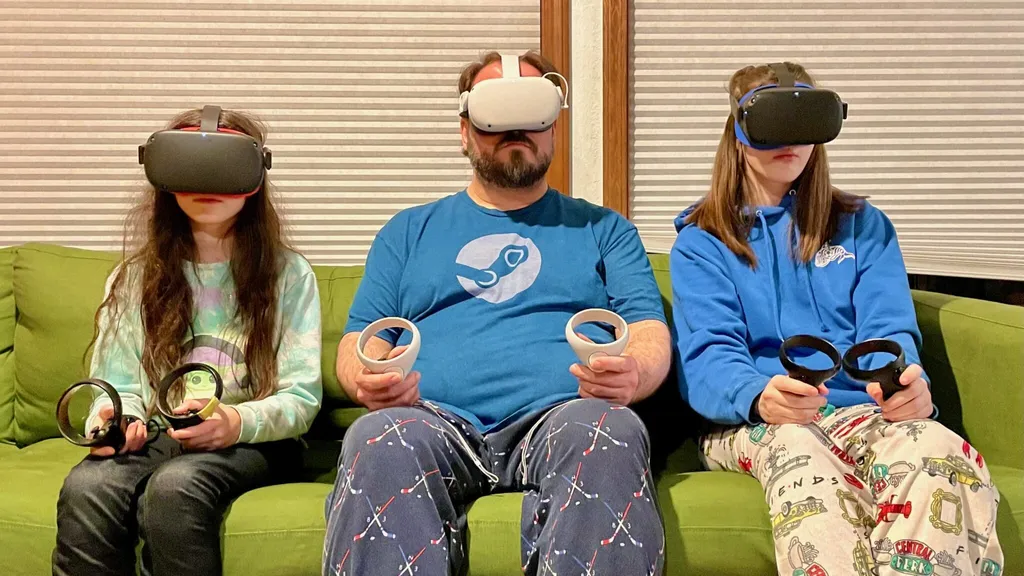I convinced my Mom and Dad to buy a Meta Quest 2 for Christmas 2020 with hopes that the “Metaverse” could bridge the physical gap between us. I’m still waiting for that to happen.
When I packed up my wife and kids and moved to Seattle in 2015, I knew that I was leaving behind my close knit Cincinnati family. Grandparents, cousins, and long time friends were now thousands of miles away instead of right across the street. Not wanting to be excluded after we moved, we attended big family gatherings via FaceTime and got passed around with just enough time to say a garbled, “Hey! Nice to see you,” then shuffled to the next aunt or uncle.
As an early adopter of technology, I find myself constantly waiting around for others to catch up and see the value of things. Over the course of my first few years in this industry, virtual reality helped me find good friends in places like Ireland, Australia, and France. Places that are much farther away from me than Cincinnati. We meet up at virtual bars, play laser tag, and enjoy movies together. Full and satisfying interaction. As cliché as it sounds, it feels like we’re really together.
It made sense for me to encourage members of my family to jump into VR as well to give us a newer, better way to interact. The tech works. It’s a decent substitute for the real thing and much better than awkwardly staring at each other on flat screens. Do you miss our New Year’s Day ritual of bowling as a family? Put on your headset and we can do that right now. Hey Dad, how about we go on a fishing trip and pull in some smallmouth bass while we discuss the latest Sportsball game?
But that didn’t happen… yet.
When I convinced my parents to buy a Quest 2, I knew it would take some time for them to get acclimated. I still have nightmares of when they first got smartphones and joined the world of social media. I also knew that my nieces would probably get the most use of it when visiting my parents. It didn’t take long for my kids to connect with their cousins to jump into Rec Room and enjoy themselves until their batteries died. But when it came time for my Mom or Dad to suit up, there was immediate resistance.
It could be my fault. Throwing my parents into very early untracked headsets with super low quality screens may have set an unfortunate precedent. I can remember my Dad playing hours of Wolfenstein 3D back in the early 90s, but when Doom came onto the scene, he couldn’t play it. It was too much for him and he got sick. Same with early VR. Now that I’m trying to get him into the newer, smoother, higher resolution VR, I wish I could persuade him to get past his previous notions and try it.
Even if it’s taking time for some members of my family to give VR a second chance now that it’s so much more compelling, I also understand there are still fundamental roadblocks making VR headsets intimidating. It takes time for habits to change and syncing up playtime with family in other time zones can still be pretty challenging, requiring passwords or room codes that can be pretty foreign to some people. But unlike previous headsets and platforms, the barriers truly are lower than ever. The destinations in VR are more beautiful, the things you can do with others are more fun, and for those reasons alone a lot more headsets are going to be charged up and ready to play a lot more often.
Maybe I’m being impatient. Once others from my parents’ generation start buying headsets they might feel the pressure to join their peers and not be left behind. That’s how Facebook evolved. What started as a “College Kids Only” club slowly became a haven for parents sharing photos with grandparents and 50th grade school reunion pages. How long before there are “Seniors Only” nights in the Metaverse? Would mainstream mass adoption be enough for my parents to meet me in VRChat? When the neighbors brag about seeing their grandkids in VR every Friday, will that push my parents to jack in?
I hope that’s all it takes. I guess I can wait a bit longer for my multigenerational virtual experience. The best part of having a big family is that multiple generations can share wisdom and enjoy experiences together. In today’s world of emerging technology and whatever the Metaverse becomes, physical distance shouldn’t be a hindrance.
I still believe 2022 will be the year I see three generations of my family play together in VR, it’s just taking a little bit longer than I expected for everyone to get ready.






























